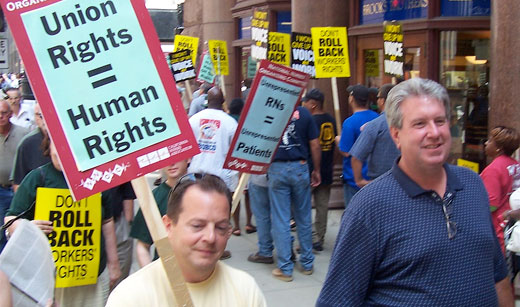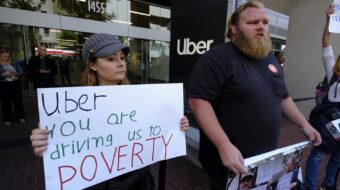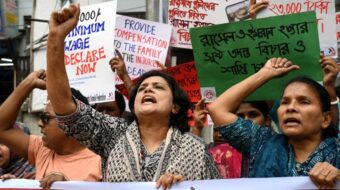
A right-wing scheme to incapacitate the National Labor Relations Board was derailed in the nation’s capital this week just before the NLRB voted on new rules that way would make it easier for workers to organize unions.
The scheme was exposed by Rep. George Miller, D-Calif., the top Democrat on the House Education and the Workforce Committee, who turned the heat up on Brian Hayes, the one Republican on the now three-member labor board, after Hayes threatened to resign. His resignation would have left the three-member board inoperable due to lack of a quorum.
Refusal by GOP lawmakers to confirm President Obama’s NLRB appointments has prevented the filling of the two vacancies that now exist on what should be a five member board.
The NLRB is charged, under the law, with protecting the union organizing rights of American workers.
Miller went on the offensive, charging that Hayes was responding to pressure from the extreme right. Over the Internet, at least, Hayes was urged to resign by a number of radical right blogs, led by redstate.com and the National Review.
Miller publically demanded disclosure of who was putting the squeeze on Hayes and why. He demanded to know whether Hayes had received a future offer of employment from any right-wing group, in exchange for resigning his post. The congressman also demanded copies of all documents between Hayes and any other parties, dealing with the topic of his resignation.
Miller charged that with open right wing requests to Hayes that he resign, the possibility of secret requests and quid pro quo offers of employment had to be considered.
“I have read reports of special interest organizations and individuals calling on you to resign precisely to incapacitate the board,” Miller wrote in a letter to Hayes. “I am also in receipt of a Nov. 21 letter from Chairman Pearce to you indicating you have indeed threatened to resign. Open calls to resign, followed by the threats you allegedly have made, raise the specter of private requests as well. I am concerned that any decision to resign prematurely will be the result of objectionable motives or improper influence.”
Hayes had told the press last week that he was actively considering resignation if that is what it would take to block the NLRB’s attempt to reform union election rules.
After the pressure from Miller, Hayes backed down and the NLRB majority approved a resolution yesterday calling upon its staff to turn proposed new union organizing rules into a formal resolution to be voted on by the board sometime between now and the end of the month.
At issue in the threatened resignation by Hayes was the NLRB’s intention to eliminate some of the roadblocks to speedy union elections, said the board’s chair, Gaston Pearce.
Although the changes don’t go nearly as far as unions would like, the labor movement has supported the proposals since they were first announced this summer. If unions had their way workers would be represented by the union as soon as a majority of employees in a bargaining unit sign pledge cards declaring their support for the union. The “card check” route to achieving union representation was the main feature of the Employee Free Choice Act, backed by majorities in both houses of Congress two years ago but filibustered by Senate Republicans.
Big business has mounted fierce opposition to the proposals. Under the law, when the NLRB proposes changes it has to consider all public comments on the proposed changes. Business lobbies, in an attempt to slow the process, deluged the board with more than 65,000 comments.
At yesterday’s meeting of the board Pearce put forward a resolution authorizing drafting of language, not an actual resolution of approval of the proposed new rules. At the meeting, however, he argued for those rules.
“The vast majority of NLRB-supervised elections, about 90 percent, are held by agreement of the parties – employees, union and employer – in an average of 38 days from the filing of a petition,” he said. “The amendments I propose would not affect those agreements.
“Instead, they apply to the minority of elections held up by needless litigation and disputes which need not be resolved prior to an election. In these contested elections, employees have to wait an average of 101 days to cast a ballot.
“As several employees testified at our hearing in July, that period can be disruptive and painful for all involved.” Pearce noted that some companies delay and defy union organizing by mounting pre-election appeals to the board and turning the resultant hearings into the scene of legal battles.
He said the board’s proposed new rules “would simply address these procedures by limiting subjects that can be raised in pre election hearings to those that are directly relevant to the election, and postponing election-related appeals until after the election.”
Not discussed at yesterday’s meeting was the variety of ways in which employers use the longer, 101 day periods between filing and the election to harass and fire union supporters and to mount intensive propaganda campaigns against unions.
Photo: Union members and allies at a 2006 rally outside the Region 13 office of the NLRB in Chicago. Carlos Fernandez, Workers Independent News. (CC BY-NC 2.0)












Comments